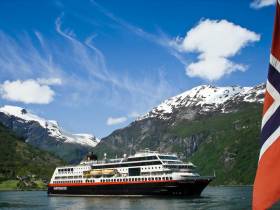Displaying items by tag: Slower Speeds
#CruiseLiners - Limitation on speed in the Norwegian World Heritage fjords is one of several measures the Norwegian Maritime Authority (NMA) is considering in order to limit pollution from ships in these areas according to Cruise Europe.
DNV GL carried out a study on the authority’s behalf to assess the effect of a speed reduction, what that speed should be and to quantify the resulting anticipated reduction in emissions.
A study of all cruise and Hurtigruten ships operating in the area between January 2016 to October 2017 resulted in the findings that using a maximum speed of 12, 10 or 8 knots would mean a reduction in total maritime emissions of 10%, 15% and 19% respectively for Geirangerfjord and in the range of 6%, 8% and 10% for Naeroyfjord. The latter lower levels are due to vessels generally maintaining a lower speed here anyway. In the summary it states that “for the collective fleet 8 knots could be an ideal lower speed limit in order to reduce emissions”.
The NMA has now given a recommendation to the Climate and Environment Ministry. Bjorn E Pedersen, head of department legislation and international relations NMA, commented: “We based our recommendation on the DNV GL report. Basically we recommend a maximum speed for ships over 25,000gt in parts of the fjords varying from eight to 12 knots .”
He pointed out that the NMA jurisdiction does not include speed regulations, hence the Coastal Administration will be the authority making the final decision.
Although he thinks it is unlikely that it will come into force this year, he does not believe it will have too great a negative impact. “Our own analysis concludes that the time lost due to a maximum speed of 10 knots will have minimum consequence on the ship schedules.” He added that in meetings with the cruiselines, no concern has been expressed with regard to the proposed speed limitation.





























































